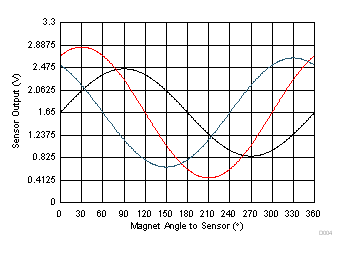SLYA036B July 2018 – November 2021 DRV5053 , DRV5053-Q1 , DRV5055 , DRV5055-Q1 , DRV5056 , DRV5056-Q1 , DRV5057 , DRV5057-Q1
- Trademarks
- 1Introduction
- 2Overview
- 3Device Descriptions
-
4Methods
- 4.1 Uncalibrated Implementations
- 4.2 Peak Calibrated Implementations
- 4.3 Lookup Table Calibration Implementations
- 4.4 Peak Calibrated Plus Lookup Table Hybrid
- 5References
- 6Revision History
4.1.5.1 Specific Implementation
With s number of sensors n° apart, the sensor system output varies for every setup, but produces s × 2 regions. For evenly spaced regions, place the sensors so that n = (180 / s)° apart. For example, Figure 4-8 and Figure 4-9 use s = 3 sensors and n = (180 / 3) = 60° and produces 3 × 2 = 6 regions. Region sizes can be adjusted by changing the degree n between each sensor. There is no calibration phase, so the peak amplitude is unknown; therefore, an example amplitude is shown. To avoid losing the benefit of each sensor, n between any given two sensors cannot approximately equal either 0° or 180°.
 Figure 4-8 Three Sensors 60° Apart
Figure 4-8 Three Sensors 60° Apart Figure 4-9 Three Sensors 60° Apart Uncalibrated Data
Figure 4-9 Three Sensors 60° Apart Uncalibrated Data